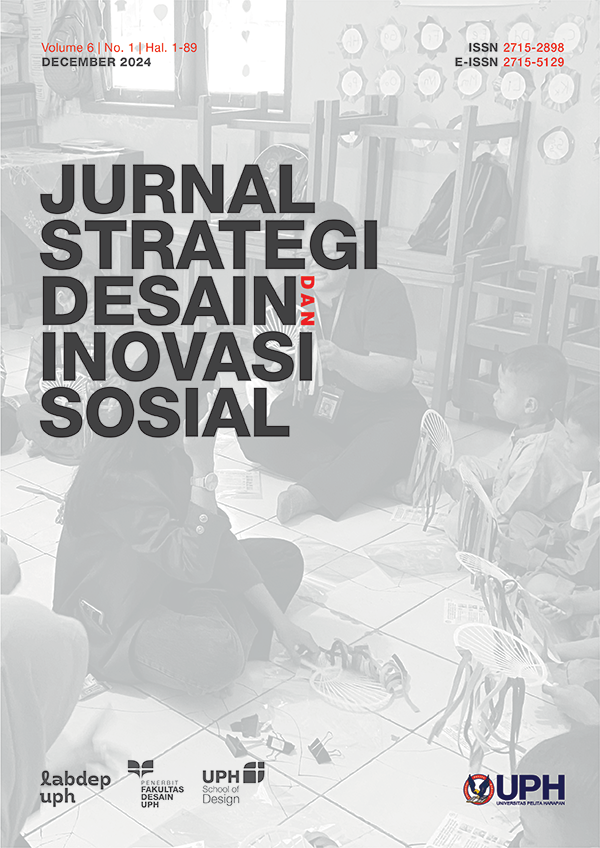EXAMINING DESIGN AS STRATEGY DISCOURSE – Part 2
Abstrak
I will review and examine each case study from the 7 papers in this JSDIS Vol. 6 Edition 1, to build a discourse on Design as Strategy. The framework for reviewing and examining each case study is to use 3 perspectives from the Design as Strategy point of view (Katoppo, 2024) which is also the sub-themes of the National Seminar on Social Design (SNDS) and the International Conference on Social Design (ICSD) 2024 (https://snds.uph.edu/), which are:
1. Body of Knowledge:
The discourse start from the point of its definition to its extent in the design field, namely system design (i.e.: visual communication design), interaction design (i.e.: product design), and spatial design (i.e.: interior design and architecture) (Grimsgaard, 2023).
2. Innovation:
In this discourse, it would investigate the causal relationship between Design as Strategy and Innovation. It will discuss how Design as Strategy becomes the driver of innovation in design practice, design pedagogy, and technology driven design (Bethune, 2022). In the context of technology driven design there are at least 3 innovation categories: the classic technology-driven innovation (Ottinger, 2021), the user- and design-driven innovation (Szymariska, 2017; Duczek, 2021), dan future artificial-driven innovation (Gartner, 2021; Beale, 2022).
3. Contribution to Social Change:
The last discourse would build around the action, where Design as Strategy is implemented to make social change. It will discuss the impact for society, for the environment and for prosperity (Amatullo, et.al (ed.), 2021).
Referensi
Amatullo, M., Boyer, B., May, J. dan Shea, A. (2021): Design for Social Innovation: Case Studies from Around the World, Routledge: USA.
Beale, M. (2022): Why AI-Driven Innovation Should Be On Your Radar, https://www.itonics-innovation.com/blog/why-ai-driven-innovation
Bethune, K. G. (2022): Reimagining Design – Unlocking Strategic Innovation, MIT Press: USA.
Coleman, C. (2002) Interior Design Handbook of Professional Practice. New York, NY: McGraw-Hill.
Cox, A. (2020). SCAMPER Technique – Reduce, Reuse, Recycle… or Reinvent-EN. Diakses pada 28 Maret 2024 dari https://netmind.net/en/scamper-technique-reduce-reuse-recycle-or-reinvent-en/#:~:text=The%20SCAMPER%20Technique%20is%20a,%2FMinimize%20and%20Rearrange%2FReverse
Duczek, M. (2021): Design for Innovation: Design Thinking and / or Design-driven Innovation, https://www.linkedin.com/pulse/design-innovation-thinking-design-driven-markus-duczek
Ferguson, K., & Candy, S. (2014). PARTICIPATORY DESIGN HANDBOOK Handbook Design and Graphics. 71
Friesen, N. (2011). Media: Digital, Ecological and Epistemological. E-Learning and Digital Media, 8(3), 175-180. https://doi.org/10.2304/elea.2011.8.3.175
Gartner®, (2021): Gartner Identifies Four Trends Driving Near-Term Artificial Intelligence Innovation, https://www.gartner.com/en/newsroom/press-releases/2021-09-07-gartner-identifies-four-trends-driving-near-term-artificial-intelligence-innovation
Gen Z Statistics 2023: How Many People Are In Gen Z? - EarthWeb. (n.d.). Retrieved September 21, 2023, from https://earthweb.com/gen-z-statistics/
Grimsgaard, W. (2023): Design and Strategy: A Step-by-Step Guide 1st ed., Routledge: NY, USA.
Han, H., & Hyun, S. S. (2020). Impact of hotel-restaurant image and quality of physical-environment, service, and food on satisfaction and intention. Journal of Hospitality and Tourism Management, 42, 1-11. https://doi.org/10.1016/j.ijhm.2017.03.006
Jukes, I., McCain, T., Crockett, L. & Prensky, M. (2010). Understanding the Digital Generation: Teaching and Learning in the New Digital Landscape (The 21ST Century Fluency Series). Melbourne: Hawker Brownlow Education.
Katoppo, M. L. (2017): DESAIN SEBAGAI GENERATOR PEMBERDAYAAN MASYARAKAT, Disertasi Program Doktor, Institut Teknologi Bandung.
Katoppo, M.L. (2018): Desain sebagai Generator: Bagaimana Desain menjadi terang bagi semua orang, Seminar Nasional Desain Sosial, Design Week 2018, ISBN: 978-602-17184-3-8, 24th, July 2018, Fakultas Desain, Universitas Pelita Harapan, Tangerang, Indonesia.
Katoppo, M. L. (2024): Design as Strategy Case Studies Part 1, Jurnal Strategi Desain dan Inovasi Sosial Vol.5, Ed. 2, Fakultas Desain, Universitas Pelita Harapan (UPH), Indonesia, 96-107, ISSN:2715-2898, E-ISSN: 2715-5129.
Koentjaraningrat, (2010). Manusia dan Kebudayaan di Indonesia. Penerbit Djambatan.
Ottinger, R. (2021): Create Sustainable Success with the 4 Types of Innovation, https://www.freshconsulting.com/insights/blog/the-4-types-of-innovation/
Lupton, E., & Lipps, A. (n.d.). The Senses. Retrieved October 15, 2023, from https://ereader.perlego.com/1/book/1099418/17?element_originalid=ch10
Mantiri, H. J. & Makainas, I. (2011): Eksplorasi terhadap Arsitektur Dekonstruksi, Media Matrasain, Jurnal Arsitektur& Perencanaan Kota Vol. 8 No. 2, Jurusan Arsitektur, Universitas Sam Ratulangi, Indonesia.
Moustakas, L. (1994). Phenomenological Research Methods. Sage Publications, Inc.
Nasaruddin. (2015). Media Dan Alat Peraga Dalam Pembelajaran Matematika. Al-Khwarizmi, 3, 21–30.
Scherling, L. S. ed. (2024). Digital Transformation in Design – Processes and Practices. Verlag, Bielefeld.
Steele, F. (1981). The sense of place. CBI Publishing Company.
Sternberg, R. J. (2002). Handbook of creativity. Cambridge: Cambridge University Press.
Sugiharto, B. (2019). Budaya dan Kondisi Post-tradisi. Penerbit Kanisius.
Szymariska, E. (2017): User-Driven Innovation – The Concept and Research Results, Procedia Engineering 182 (694-700).
Yao, K., Gao, P., Yang, X., Sun, J., Zhang, R., & Huang, K. (2022). Outpainting by Queries. Lecture Notes in Computer Science (Including Subseries Lecture Notes in Artificial Intelligence and Lecture Notes in Bioinformatics), 13683 LNCS, 153–169. https://doi.org/10.1007/978-3-031-20050-2_10
Zeng, J., Abidin, C., & Schäfer, M. S. (2021). Research Perspectives on TikTok & Its Legacy Apps. International Journal of Communication, 15(September), 3161–3172.
Unduhan
Diterbitkan
Terbitan
Bagian
Lisensi
Hak Cipta (c) 2025 Martin Luqman Katoppo

Artikel ini berlisensiCreative Commons Attribution-NonCommercial-ShareAlike 4.0 International License.
Dengan mempublikasikan artikel pada Jurnal Strategi Desain dan Inovasi Sosial (JSDIS), penulis setuju bahwa:
- Penulis memegang penuh hak cipta atas artikel yang dipublikasikan.
- Penulis tidak pernah mempublikaskan artikel penulis dalam publikasi lainnya.
- Penulis dilarang mempublikasikan artikel yang sudah diterbitkan JSDIS tanpa mencantumkan bahwa artikel tersebut sebelumnya sudah pernah diterbitkan di JSDIS.
- Redaksi JSDIS memiliki hak untuk mempublikasikan, mendistribusikan, dan menggunakan artikel penulis untuk keperluan publikasi jurnal dengan tetap mencantumkan penulis sebagai pemegang hak cipta.



.jpg)
